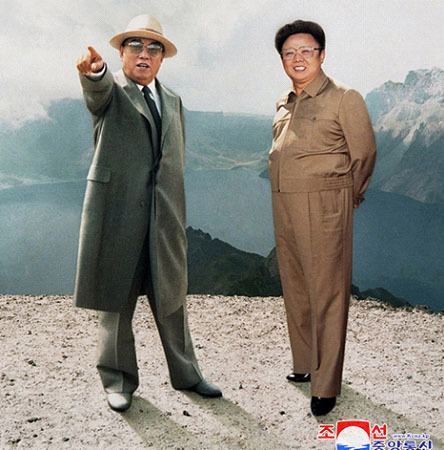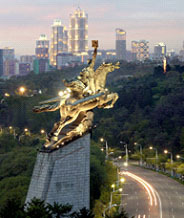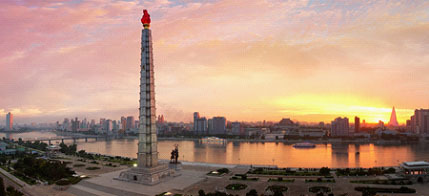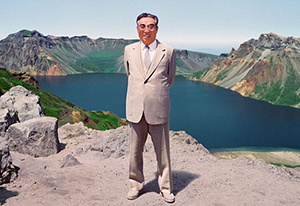
Over the past seven decades of its development the country has demonstrated its dignity and honour, overcoming all sorts of challenges and difficulties.
We look back on its history through the names it was called in each period.
“Democratic Korea”
On August 15, 1945, Korea was liberated from Japan’s military occupation. It was a task of the times confronting the Korean people to decide which road the new Korea should take. Korea adopted the road of Korean-style democracy, progressive democracy, not the road of Soviet-style democracy nor the US-style democracy. On the basis of the founding of the people’s government and the implementation of democratic reforms such as the agrarian reform, nationalization of key industries and gender equality, the Democratic People’s Republic of Korea, the people’s country with the working masses as its masters, was founded on September 9, 1948. The world people called the new Korea democratic Korea.
“Heroic Korea”
The Korean war (1950-1953) waged by the imperialist allied forces led by the US that boasted of being the “strongest” in the world to stifle the DPRK, which was only two years old since its founding, was literally a “confrontation between an A-bomb and a rifle.”

“Chollima Korea”
The appearance of post-war Korea was such that it could not be expressed otherwise than “ashes.” The US claimed that Korea could not rise again even in one hundred years.
However, the Korean people have turned out in the struggle to create a new life. After completing reconstruction in less than three years, it carried out the centuries-old task of socialist industrialization in 14 years, running in the spirit of legendary Chollima, a horse that can run 400 kilometres a day. The word Chollima Korea widely spread in the world.

The whole course covered by the DPRK can be called the process of applying the Juche idea. After its founding, the country has achieved remarkable successes in socialist construction by thoroughly applying the Juche idea and dealing with everything in conformity with its specific conditions and the interests of its people. Universal free medical care and free education were enforced and a heyday of socialism was opened in all fields of society.
The Juche idea has been widely disseminated to the world; more than 1 100 research and dissemination organizations in over 100 countries have been formed with the International Institute of Juche Idea and regional organizations as the centres.
The country has become widely known as the land of Juche.


“Socialist Fortress”
The collapse of socialism in one country after another at the end of the last century weakened the faith in socialism among many people of the world. At that time, Chairman Kim Jong Il of the National Defence Commission of the DPRK made public important works, including Socialism Is a Science, which proved the scientific accuracy and truthfulness of socialism and the inevitability of its victory. The country smashed by dint of the treasured sword of Songun politics the general offensive the imperialist allied forces had launched to stifle it availing themselves of the collapse of the world socialist camp, firmly defended its socialist system and ushered in a new era of building a powerful socialist country. The DPRK has become recognized by the international community as a socialist fortress which no one can destroy with anything.
“Country of Single-hearted Unity”
Many people in the world are surprised to see the DPRK advancing along the road of independence without the slightest vacillation in the face of severe trials and challenges of history.
The dangerous military pressure by the hostile forces and the hideous economic blockade which could not be otherwise described as being aimed at “annihilating a nation” could not bring the Korean people to their knees.
How could the DPRK, which is not so large in terms of population and territory, overcome such tremendous challenges? The secret was the single-hearted unity in which the national leader and the people share the intention and destiny. This single-minded unity is unique to the DPRK, which no country can imitate nor possess and is the most powerful political weapon that cannot be destroyed even by a nuclear bomb. The country of single-hearted unity is the most correct name characterizing the DPRK.
 Kim Il Sung and Non-aligned Movement
Kim Il Sung and Non-aligned Movement
Sixty years have elapsed since the Non-aligned Movement made its official appearance on the international arena. The First Summit Conference of the Non-aligned Nations was held in September 1961 in Belgrade, Yugoslavia, with the participation of representatives of 25 official member states and three observer states, signalling the start of the movement.
This was an event of great significance in making the 20th century an era of the cause of anti-imperialist independence.
Although the Democratic People’s Republic of Korea was not a member state of the movement (it became a member state in August 1975), President Kim Il Sung (1912-1994) paid close attention to the movement which was opposed to military blocs and aspiring to build an independent and peaceful world from its outset.
He made great efforts to realize the consolidation and development of the movement and unity and solidarity of its member states with an understanding that the mission of the movement was to oppose all forms of domination, subjugation, aggression and intervention, defend peace and security, realize the independence of countries and nations and achieve free social and economic development.
In many of his talks and other works including The Non-aligned Movements Is a Mighty Anti-imperialist Revolutionary Force of Our Times published in December 1975 in the inaugural issue of Guidebook to the Third World, a periodical published in Argentina, he gave a scientific definition that the movement embodying the lofty ideal of anti-imperialist independence was a powerful one opposed to imperialist and colonialist aggression and plunder, and that the member states constitute a strong force standing in confrontation with the imperialist reactionary forces; and he gave answers to many theoretical and practical problems arising in consolidating and developing the movement–that the member states should confront the schemes of the imperialists for division and alienation with the strategy of unity, that they should maintain the principle of noninterference in the one another’s internal affairs, that they should settle their disagreements and disputes by means of negotiation, and so on.
He also led his country to fulfil its mission and role as a member state of the movement.
The complicated international situation created in the end of 1980s and early 1990s exerted a harmful influence on the Non-aligned Movement as well as on the socialist forces.
Taking advantage of the disappearance of the cold war structure and the destruction of the balance of forces on the international arena, imperialists attempted to emasculate and obliterate the fundamental ideals and character of the movement which had fought for anti-imperialist independence, peace against war and progress.
In the end of August 1992 the chief editor of the Indonesian newspaper Media Indonesia asked Kim Il Sung to give answers to the questions regarding the orientation of the development of the Non-aligned Movement.
It was just before Indonesia was to host the 10th Summit Conference of the Non-aligned Nations.
The conference was supposed to make an accurate evaluation of the prevailing situation and achieve a consensus of opinion on the important issues related to the road the Non-aligned Movement should take. By that time, however, the member states failed to reach a consensus on some matters or even take a clear-cut stand.
Kim Il Sung replied: The end of the cold war on no account means that the Non-aligned Movement has forfeited its position and role; since the imperialist forces of domination remain, and since the ideal of non-alignment has yet to be realized, the Non-aligned Movement must continue to exist and to strengthen and develop; there is no change in the world people’s aspiration to build a free, peaceful new world, and advancing towards independence and peace is the fundamental historical tide that cannot be turned back; the movement, which regards independence as its lifeblood, must invariably uphold its fundamental ideal and principles.
And he illustrated the direction for further consolidating and developing the movement.
His opinions became the spirit of the 10th Summit Conference of the Non-aligned Nations, and the conference marked an important occasion in maintaining the mission and role of the movement aspiring after independence.
Kim Il Sung also concerned himself with the information work of the Non-aligned Movement.
Kim Il Sung met the heads and representatives of foreign delegations to the Fourth Conference of the Ministers of Information of the Non-aligned Countries held in Pyongyang in June 1993.
In his speech Non-aligned Information Services Must Contribute to the People’s Cause of Independence given to the participants of the conference, he said: The Non-aligned Movement is, in essence, a movement to make the whole world democratic and independent; as long as there exists on the globe a force that seeks domination and intervention, aggression and plunder, the Non-aligned Movement must be continuously developed and further expanded and strengthened as the leading force in the building of an independent new world.
It is noteworthy that the DPRK proposed to set September 1 as the day of Non-aligned Movement and that all the member states celebrate it every year. The proposal reflected the far-reaching intention and will of Kim Il Sung who wanted to make the day of the start of the movement an important occasion and a driving force for the continuous development and advance of the movement. This proposal by the DPRK delegation to a meeting of foreign ministers of the non-aligned countries held in February 1981 in New Delhi, India, was welcomed by all the participants.
A former foreign minister of Indonesia, who had watched the process of development of the Non-alignment Movement, had this to say: The DPRK is playing an independent role on the international arena and a definitely leading role in the Non-aligned Movement in particular; it was the DPRK that saved the organic body, called Non-aligned Movement, by giving it vaccine in time when it was suffering from the political fever of “liberalization” and “multi-party system” after the end of the cold war; it was also the DPRK that made the movement come to its sense when it was knocked out in a ring by the heavy strike of the Western forces; it is entirely the exploit of President Kim Il Sung that the DPRK saved the movement and is leading it.


